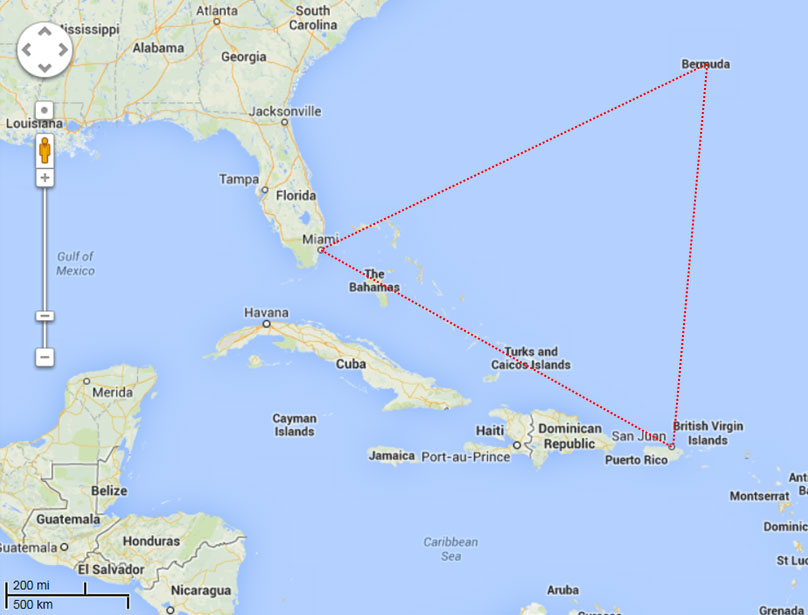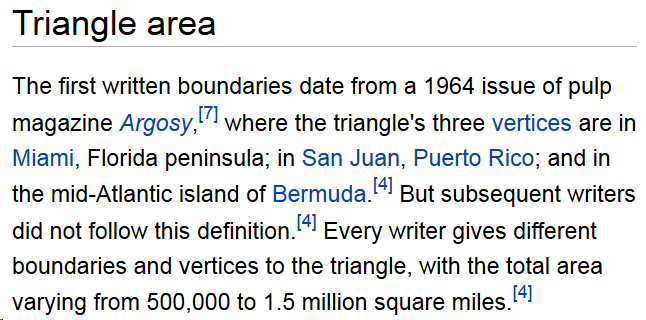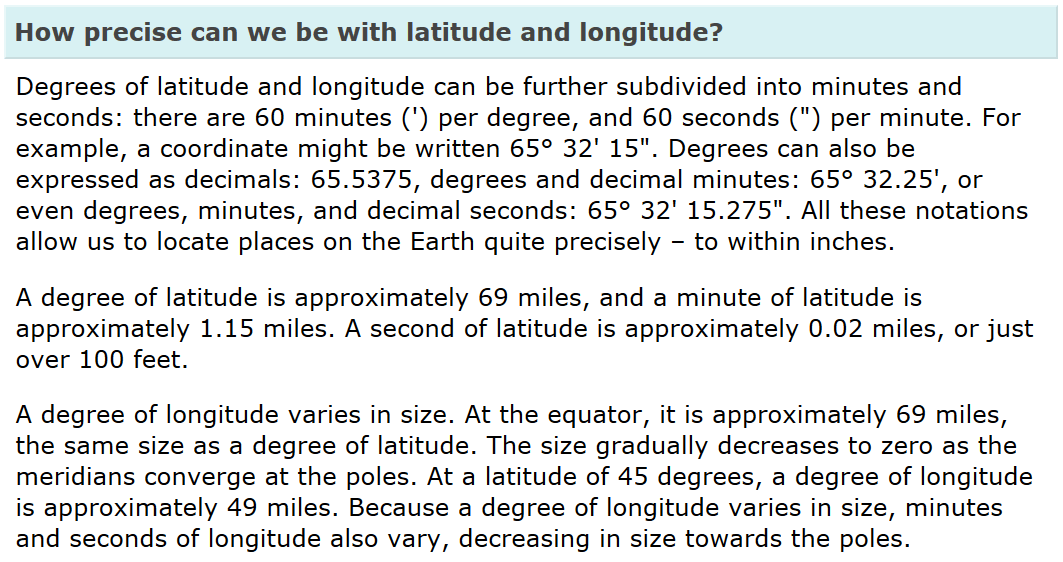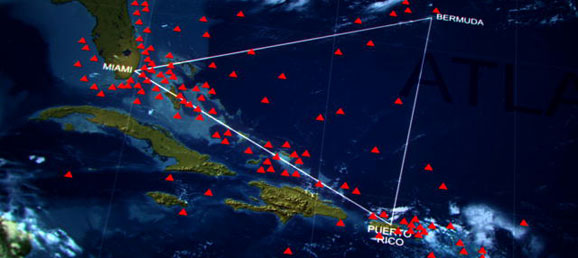Download
The Situation
The Challenge(s)
- How big is the Bermuda Triangle?
Question(s) To Ask
- What is a guess that is too low?
- What is a guess that is too high?
- What is your best guess?
- What assumptions are we making?
- How can we determine whether the GPS coordinate corresponds with the x or y coordinate?
- What have we learned that may be useful in determining the triangle’s area?
Consider This
Here are my assumptions below to consider when using this problem:
- The Bermuda Triangle is a triangle whose vertices are not well defined but are generally locations in Florida, Puerto Rico, and Bermuda.
- For Florida, it seems like Miami is the most common location.
- The GPS coordinates for Miami are: (25.789106, -80.226529)
- For Puerto Rico, it seems like San Juan is the most common location.
- The GPS coordinates for San Juan are: (18.4663188, -66.1057427)
- For Bermuda, I have no idea so I am using Hamilton which is the capitol of Bermuda.
- The GPS coordinates for Hamilton are: (32.294887, -64.781380)
- For Florida, it seems like Miami is the most common location.
- I am using the latitude and longitude coordinates as my (x,y) coordinates. However, the first coordinate is the latitude which is the y-value and the second coordinate is the longitude which is the x-value. If you want students to figure this out on their own, I recommend giving them a piece of graph paper and asking them to plot and label the points. Then compare it to a map and facilitate a conversation around why they look different. So, as an ordered pair, the coordinates are:
- Miami: (-80.226529, 25.789106)
- San Juan: (-66.1057427, 18.4663188)
- Hamilton: (-64.781380, 32.294887)
- I am being intentionally vague about what “big” means in the question. It should provide an opportunity to attend to precision so you can discuss what we are measuring and what units we will use to measure it with.
- According to Wikipedia (screenshot included in “What You’ll Need”) “the total area var[ies] from 500,000 to 1.5 million square miles” depending on the boundaries and vertices of the triangle. You will notice in the movie clip that in addition to the triangle drawn, the red area is much larger as I assume that shows area roughly in the Bermuda Triangle.
- I am ignoring the fact that the Earth is an ellipsoid and treating the section of the map like it is a flat plane. This is important when converting from degrees to a linear unit like miles. National Atlas (screenshot included in “What You’ll Need”) explains this in more detail. For now I am assuming that one degree equals 69 miles in every direction. Later we can discuss it as a potential source of calculation error.
Here are several different methods students may use:
- While I am intending for this to be a high school level lesson, if you give students a map with scale like the one below you can get a reasonably accurate measurement by using the traditional triangle area formula of 1/2*base*height. I got 470,080 square miles when I used this method.

- Students may choose to enclose the triangle in a rectangle and subtract out the three extra triangles from the total. The way I approached it, I translated the xy-coodinates for Miami to (0,0). That made the xy-coordinates for San Juan (14.12079, -7.32279) and Hamilton (15.44515, 6.505781). I then graphed it on Desmos. The dashed rectangle that inscribes the triangle has an area of 213.5843 square degrees. The triangles on the right, top, and bottom have areas of 9.15702, 50.24138, and 51.70176 square degrees, respectively. That leaves an area of 102.4841 square degrees for the Bermuda Triangle. Based on our assumption of a degree being 69 miles, a square degree would be 4761 square miles. That would give an area of 487,926.8 square miles.

- Students may use the formula for finding the area of a triangle by setting up the coordinates as a 3×3 matrix and finding the absolute value of half the determinant. That also gives the Bermuda Triangle an area of 102.4841 square degrees which is 487,926.8 square miles.

Once students have their guesses, you can play the answer for them.
What You'll Need
- Wikipedia on the Bermuda Triangle’s area and vertices:

- National Atlas on the length of a degree:

Content Standard(s)
- CCSS G-GPE.7 Use coordinates to compute perimeters of polygons and areas of triangles and rectangles, e.g., using the distance formula.
- CCSS N-VMQ.12 Work with 2 × 2 matrices as a transformations of the plane, and interpret the absolute value of the determinant in terms of area.
Source(s)
- The GPS Coordinates – Miami, Florida
- The GPS Coordinates – San Juan, Puerto Rico
- The GPS Coordinates – Hamilton, Bermuda
- Discovery Channel
- National Atlas
- Wikipedia
- Desmos
Download



Great Activity! We used GIS Online to check how our mathematical answer compared to the one produced by the software. Students were excited when their responses/methods were close to the software result.
Raymond
Thanks for letting me know Raymond. If you blog about your experiences in more detail, I’d love to include them in the lesson.